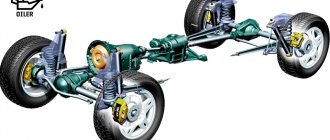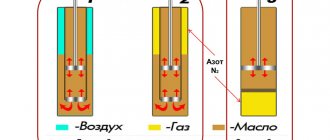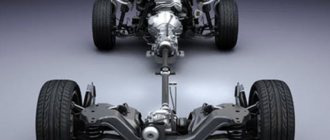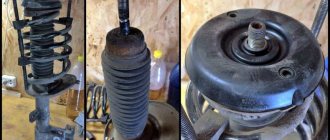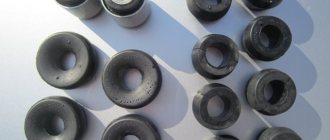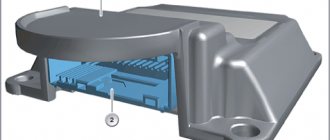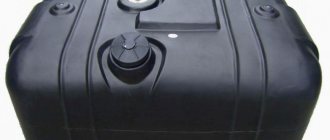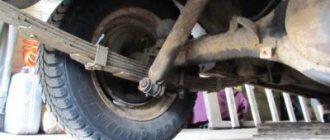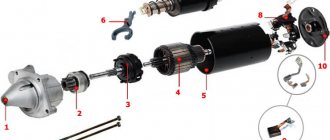A shock absorber is a damping device that is used on a car to effectively absorb shocks and shocks, dampen vibrations, etc. Also, the shock absorber (car strut) allows you to press the wheel to the road when driving on rough roads, thereby improving traction properties, increasing braking efficiency, vehicle stability, etc.
Today there are several types and types of shock absorbers, which differ not only depending on the axis on which they stand (front shock absorbers or rear shock absorbers), but also in design terms.
Next, we will look at what a shock absorber is and what a car's shock absorber is. So, within the framework of the article, a separate emphasis is placed on what types of shock absorbers there are on cars, types of struts, how they differ, and also the advantages and disadvantages of various types of struts, etc. are considered.
What is a shock absorber
A modern shock absorber is a complex mechanism that dampens vibrations, absorbs shocks and ensures constant contact of the wheels with the road surface when the car is moving. It is installed next to the wheel. Using a lever system, mechanical loads (shocks and vibrations) are transmitted from the rotating wheel to the mechanism.
This part is equipped with a spring, which ensures quick return of the rod after compression when hitting a bump. If this process does not occur quickly, then the car will become uncontrollable off-road.
Diagnosis
The slightest suspicion of a malfunction requires immediate diagnostic work. There are measures that a car enthusiast can do on his own, which will be the first test of the struts.
We recommend:
Mud tires: what they are, what they are needed for, price and where to buy
Some car owners do without testing at the stand and spontaneously rock their vehicles in order to determine the shock absorbers. True, this check is very ineffective, since the weakening and performance of the racks does not affect the swaying of the vehicle, in the end it seems that everything is in order.
The history of the shock absorber
As transport evolved, designers came to the conclusion that, in addition to a powerful and efficient power unit with a durable body, the car needed a good suspension that would soften the impact of uneven roads. The first shock absorbers had an unpleasant effect - while driving they strongly rocked the vehicle, which caused the steering to suffer greatly.
Spring shock absorbers partially damped body vibrations due to the friction force between the sheets, but this effect was not completely eliminated, especially when the vehicle was heavily loaded. This prompted designers to develop two separate elements. One was responsible for softening the impacts from the wheel on the body, and the other restored the contact patch of the wheel, springing it, quickly bringing the damper element to its original position.
At the beginning of the last century, a separate damping suspension element was developed. It was a dry friction shock absorber, which included friction discs. The first piston oil telescopic shock absorbers appeared in the 50s of the last century. The basis of their work was the principle of fluid friction.
The design of such shock absorbers was borrowed from the design of an aircraft landing gear. This type of shock absorber design is still used today.
Silent blocks
All moving suspension elements are attached to the body through rubber inserts - silent blocks. They dampen vibrations from one part to another. They consist of two metal bushings with a rubber element between them. Due to its plasticity, vibrations during operation of moving parts of the chassis are dampened and their mobility is ensured.
For example, if there were no silent block at the place where the lever is attached to the frame, the lever would rub against the frame. This connection increased the wear of the metal and produced a terrible squeak when the car moved. In addition, any impacts on the wheel from the road were transmitted to the body, you would hear knocking noises. This would quickly break the fastening unit.
Therefore, when independently diagnosing a car’s suspension, pay attention to the condition of the silent blocks. They should not have cracks or damage. There are times when the inner bushing peels off from the rubber and begins to dangle and knock.
Shock absorber design
Most shock absorbers consist of the following components:
- Steel hollow tube (cylinder). On one side it is muffled. An eye is welded to this part, which allows you to secure the stand to the wheel hub. The reservoir is filled with liquid (a mixture of gas and liquid or gas only), which compensates for the load when the piston is compressed. A rod seal is installed on the open side, preventing fluid from leaking out of the cavity.
- Shock absorber rod. This is a steel rod, the cross-section of which depends on the model of the mechanism. It is placed in a tank. On one side, the rod is attached to a support bearing, and on the other, a piston placed inside the cylinder is attached to it.
- Piston. This element moves inside the cylinder, creating pressure on the liquid or gas inside the tube.
- Bypass valve. It is mounted on the piston and has several holes with spring-loaded valves. When the piston moves, one group of valves is activated, ensuring flow from the cavity under the piston to the part above it. Smooth running is ensured by resistance due to small holes (the liquid does not have time to move quickly between the cavities). A similar process occurs during the recoil stroke (when the piston rises), only in this case the valves of another group are activated.
The design of modern damper mechanisms is constantly being improved, which increases their efficiency and reliability. The design of shock absorbers can differ significantly depending on the modification of the mechanism. However, the operating principle remains unchanged. When pushed, the rod moves the piston inside the cylinder, which compresses the liquid or gas.
Sometimes shock absorbers are confused with gas springs, which are installed on the trunk lid or on the hood. Although they look similar, they each serve a different function. Dampers dampen shocks, and gas springs ensure smooth opening and retention of heavy lids in this position.
What is the difference between shock absorbers and struts?
The shock absorber and strut are attached differently. The rack design eliminates the need for an upper ball joint and linkage. It is attached to the lever and ball only at the bottom, and at the top it is installed in a support bearing.
The shock absorber itself is attached using silent blocks without a support bearing. The rod of the strut has a large diameter, while the rod of the shock absorber has a small diameter. Thanks to this method of fastening, the rack is able to absorb multidirectional loads, and the shock absorber - only along its axis. The shock absorber may be part of the strut.
Price
Many users decide for themselves which struts are better, gas or oil, based on considerations of financial gain. Prices for oil shock absorbers start from 900 rubles, and gas shock absorbers from 2000 rubles. But branded products cost several times more. And even in the case of cars of popular brands.
Petr Alekseev
Regular author of articles for the magazine rating cars.
Why are shock absorbers needed?
When creating vehicles, early developers faced a serious problem. While driving on the road, the driver experienced terrible discomfort from constant shaking. In addition, due to the loads, parts of the chassis quickly failed.
To eliminate the problem, they began to put rubber hoses spread out lengthwise on the wheels. Then springs appeared that dampened bumps, but the vehicle lacked stability. On bumps the car swayed violently.
The first shock absorbers appeared in 1903, and were made in the form of springs attached to levers near each wheel. They were mainly installed on sports cars, since horse-drawn vehicles did not need such a system due to low speeds. Over the years, this development has been improved, and friction shock absorbers have been replaced by hydraulic analogues.
